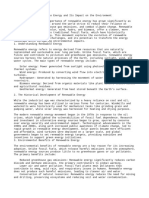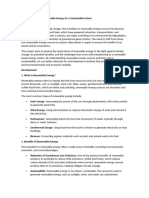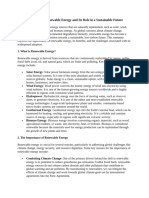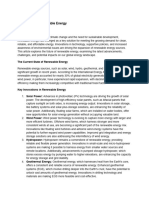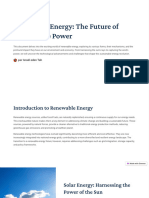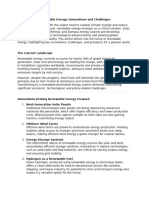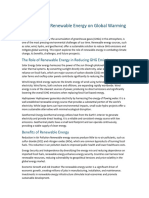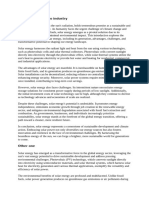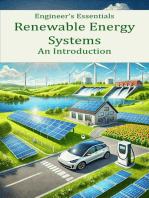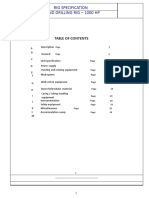The Future of Renewable Energy
The Future of Renewable Energy
Uploaded by
hervorragendintensivergorillaCopyright:
Available Formats
The Future of Renewable Energy
The Future of Renewable Energy
Uploaded by
hervorragendintensivergorillaCopyright
Available Formats
Share this document
Did you find this document useful?
Is this content inappropriate?
Copyright:
Available Formats
The Future of Renewable Energy
The Future of Renewable Energy
Uploaded by
hervorragendintensivergorillaCopyright:
Available Formats
The Future of Renewable Energy: A Path to Sustainability
As the world grapples with the pressing challenges of climate change,
dwindling natural resources, and environmental degradation, the
transition to renewable energy sources has emerged as a beacon of hope.
Renewable energy, derived from natural processes that are replenished
constantly, offers a sustainable alternative to fossil fuels. This document
explores the various facets of renewable energy, its benefits, and its
potential to shape a sustainable future.
1. The Rise of Renewable Energy
Over the past few decades, renewable energy has experienced significant
growth. Technological advancements, coupled with increasing
environmental awareness, have driven the adoption of renewable energy
sources such as solar, wind, hydro, and geothermal power. Governments
and private sectors worldwide are investing heavily in renewable energy
infrastructure, aiming to reduce carbon footprints and achieve energy
independence.
2. Solar Power: Harnessing the Sun's Energy
Solar power is one of the most promising renewable energy sources.
Photovoltaic (PV) cells convert sunlight directly into electricity, providing a
clean and abundant energy source. Solar panels can be installed on
rooftops, in solar farms, and even integrated into building materials.
Innovations in solar technology, such as increased efficiency and reduced
costs, have made solar power more accessible to households and
businesses alike.
3. Wind Energy: Capturing the Power of the Wind
Wind energy is another rapidly growing sector in the renewable energy
landscape. Wind turbines, both onshore and offshore, convert the kinetic
energy of wind into electricity. Advances in turbine design and materials
have led to more efficient and reliable wind energy systems. Wind farms
are now a common sight in many countries, contributing significantly to
the global energy mix.
4. Hydropower: Utilizing Water's Potential
Hydropower, one of the oldest forms of renewable energy, continues to
play a vital role in the energy sector. By harnessing the energy of flowing
or falling water, hydropower plants generate electricity with minimal
greenhouse gas emissions. Large-scale dams and small-scale hydro
projects provide a reliable and consistent energy source, particularly in
regions with abundant water resources.
5. Geothermal Energy: Tapping into Earth's Heat
Geothermal energy leverages the heat from the Earth's core to generate
electricity and provide heating. Geothermal power plants use steam
produced from reservoirs of hot water found below the Earth's surface.
This energy source is highly reliable and can provide a constant power
supply, making it an attractive option for baseload power generation.
6. The Environmental and Economic Benefits
The shift to renewable energy offers numerous environmental and
economic benefits. By reducing reliance on fossil fuels, renewable energy
helps decrease greenhouse gas emissions, mitigating the impact of
climate change. Additionally, renewable energy projects create jobs,
stimulate economic growth, and enhance energy security. The
decentralization of energy production also empowers communities,
allowing them to generate their own power and reduce dependence on
external sources.
7. Challenges and Solutions
Despite the many advantages, the transition to renewable energy is not
without challenges. Intermittency issues, such as the variability of solar
and wind power, require the development of advanced energy storage
solutions and smart grid technologies. Moreover, the initial investment
costs for renewable energy infrastructure can be high. However,
continued research, innovation, and supportive policies are addressing
these challenges, making renewable energy more viable and cost-
effective.
8. The Role of Policy and Innovation
Government policies and incentives play a crucial role in promoting
renewable energy adoption. Subsidies, tax credits, and renewable energy
mandates encourage investment and development in the sector.
Additionally, ongoing innovation in technology and financing models is
driving down costs and improving the efficiency of renewable energy
systems.
9. A Vision for the Future
The future of renewable energy is bright, with the potential to transform
the global energy landscape. As technology continues to advance and
economies of scale are realized, renewable energy will become
increasingly competitive with traditional energy sources. The integration
of renewable energy into the grid, coupled with energy storage and smart
technologies, will pave the way for a sustainable and resilient energy
system.
Conclusion
Renewable energy represents a critical component of the global strategy
to combat climate change and achieve sustainable development. By
embracing renewable energy sources, we can reduce our environmental
impact, enhance energy security, and create a more sustainable future for
generations to come. The journey towards a renewable energy future is
challenging, but the rewards are immense, promising a cleaner, healthier,
and more prosperous world.
This document provides an overview of the current state and future
potential of renewable energy, highlighting its importance in creating a
sustainable future.
You might also like
- Volvo EW140B Wheeled Excavator Service Repair Manual Instant DownloadDocument22 pagesVolvo EW140B Wheeled Excavator Service Repair Manual Instant Downloadvrdmen5302No ratings yet
- Untitled DocumentDocument3 pagesUntitled Documentcooperjwr1No ratings yet
- The Evolution of Renewable Energy and Its Impact On The EnvironmentDocument3 pagesThe Evolution of Renewable Energy and Its Impact On The EnvironmentDexNo ratings yet
- The Importance of Renewable Energy for a Sustainable FutureDocument3 pagesThe Importance of Renewable Energy for a Sustainable FutureRaiserNo ratings yet
- Renewable Energy DocumentDocument2 pagesRenewable Energy DocumenttipulblogNo ratings yet
- The Green Revolution - How Renewable Energy Is Reshaping The WorldDocument3 pagesThe Green Revolution - How Renewable Energy Is Reshaping The WorldMaalav WhorraNo ratings yet
- The Role of Renewable Energy in Combating Climate ChangeDocument4 pagesThe Role of Renewable Energy in Combating Climate ChangeNur Ad-DujaNo ratings yet
- The Role of Renewable Energy in Combating Climate ChangeDocument3 pagesThe Role of Renewable Energy in Combating Climate Changecapov18236No ratings yet
- whatever 3Document3 pageswhatever 3Τάκης ΠρεφτίτσηςNo ratings yet
- The Role of Renewable EnergyDocument4 pagesThe Role of Renewable EnergySaurabh Patel TroublesomeNo ratings yet
- EnergyDocument12 pagesEnergyscribdd1No ratings yet
- EssayDocument3 pagesEssayanwarmahinoor754No ratings yet
- Embracing The Renewable Revolution Exploring The Future of Renewable EnergyDocument3 pagesEmbracing The Renewable Revolution Exploring The Future of Renewable Energya_s_1_5No ratings yet
- New Microsoft Word Document (5)Document4 pagesNew Microsoft Word Document (5)rashidmkabirNo ratings yet
- Renewable Energy SourcesDocument2 pagesRenewable Energy SourcesEnrik ShenepremteNo ratings yet
- The Future of Renewable EnergyDocument3 pagesThe Future of Renewable EnergyRohitNo ratings yet
- Renewable Energy Powering A Sustainable FutureDocument4 pagesRenewable Energy Powering A Sustainable FuturespamujmniejeszczeNo ratings yet
- Renewable EnergyDocument6 pagesRenewable Energygargi3No ratings yet
- Renewable Energy A Sustainable FutureDocument10 pagesRenewable Energy A Sustainable Futureshivendramss20No ratings yet
- The Promise of Renewable EnergyDocument2 pagesThe Promise of Renewable Energyrajnarayanshukla69No ratings yet
- Role of Renewable Energy in Sustainable DevelopmentDocument4 pagesRole of Renewable Energy in Sustainable Developmentanuragsenapati48No ratings yet
- The Importance of Renewable Energy in Combating Climate ChangeDocument2 pagesThe Importance of Renewable Energy in Combating Climate Changequiz-had0nNo ratings yet
- Renewable Energy the Future of Sustainable PowerDocument10 pagesRenewable Energy the Future of Sustainable PowerIsraël eden TahNo ratings yet
- ghrktyheyDocument2 pagesghrktyheyengrstraNo ratings yet
- Renewable Energy Powering A Sustainable FutureDocument5 pagesRenewable Energy Powering A Sustainable FutureParas BhasinNo ratings yet
- Renewable energi combating climate changeDocument6 pagesRenewable energi combating climate changejoko16273No ratings yet
- Renewable EnergyDocument4 pagesRenewable EnergyGauri UdyavarNo ratings yet
- Renewable Energy - The Future of Sustainable PowerDocument8 pagesRenewable Energy - The Future of Sustainable Powerkgnmk1997No ratings yet
- The Role of Renewable Energy in Combating Climate ChangeDocument2 pagesThe Role of Renewable Energy in Combating Climate Changequiz-had0nNo ratings yet
- Research Repor5Document4 pagesResearch Repor5vihaanmeraniNo ratings yet
- The Future of Renewable EnergyDocument3 pagesThe Future of Renewable Energyagoustin BiswasNo ratings yet
- R2 - Renewable Energy - Climate ChangeDocument2 pagesR2 - Renewable Energy - Climate ChangeFrancisNo ratings yet
- Essay On Renewable EnergyDocument2 pagesEssay On Renewable Energymishra.bibha119No ratings yet
- Essay 8Document2 pagesEssay 8Yashcharan MUINo ratings yet
- The Path To A Sustainable Future Embracing Renewable EnergyDocument2 pagesThe Path To A Sustainable Future Embracing Renewable Energyaulia viciNo ratings yet
- Argumentative Essay LangstonDocument6 pagesArgumentative Essay LangstonBrilliant WritersNo ratings yet
- The Future of Renewable Energy_ Challenges and InnovationsDocument4 pagesThe Future of Renewable Energy_ Challenges and Innovationstlc7spNo ratings yet
- Renewable Energy Basics by BhaumikDocument2 pagesRenewable Energy Basics by BhaumikIts MeNo ratings yet
- The Importance off renewable energyDocument4 pagesThe Importance off renewable energyjoko16273No ratings yet
- SIPDocument10 pagesSIPfardin.mercuryNo ratings yet
- Essay 5Document2 pagesEssay 5Hardik Kashyap VepariNo ratings yet
- The Future of Renewable EnergyDocument2 pagesThe Future of Renewable EnergyceliadessardNo ratings yet
- Title - "The Power of Renewable Energy - Building A Sustainable Future"Document1 pageTitle - "The Power of Renewable Energy - Building A Sustainable Future"mfabregamarinNo ratings yet
- Subject Activity Report 2023 - 2024: VI Semester B.EDocument9 pagesSubject Activity Report 2023 - 2024: VI Semester B.EKeshav MishraNo ratings yet
- Sustainable Development and Renewable EnergyDocument4 pagesSustainable Development and Renewable EnergyBereket AlemuNo ratings yet
- Sustainable EnergyDocument2 pagesSustainable Energymerna.esam3010No ratings yet
- Research Paper 3Document3 pagesResearch Paper 3FredNo ratings yet
- CertainlyDocument2 pagesCertainlygoleta4404No ratings yet
- converted_text (2)Document2 pagesconverted_text (2)moaz35361No ratings yet
- THE ROLE OF RENEWABLE ENEGY IN THE FUTUREDocument11 pagesTHE ROLE OF RENEWABLE ENEGY IN THE FUTUREAyeshaNo ratings yet
- Energy techsDocument17 pagesEnergy techsMohammed faizalNo ratings yet
- The Future of Renewable Energy - A Sustainable Path Towards A Brighter TomorrowDocument2 pagesThe Future of Renewable Energy - A Sustainable Path Towards A Brighter TomorrowBruwnoNo ratings yet
- d1997f0537a82532Document19 pagesd1997f0537a82532Mohammed faizalNo ratings yet
- Renewable energyDocument1 pageRenewable energyparthivrik1958a2No ratings yet
- IFS UmerDocument11 pagesIFS UmerAhadism AnalysisNo ratings yet
- Renewable_Energy_Scholarly_SanitizedDocument7 pagesRenewable_Energy_Scholarly_Sanitizedkimkh1517No ratings yet
- 7 Tech RepDocument13 pages7 Tech RepFe MonteronNo ratings yet
- 1Document2 pages1rookie.abiNo ratings yet
- The Rise of Renewable Energy A Sustainable FutureDocument1 pageThe Rise of Renewable Energy A Sustainable FuturetdctopNo ratings yet
- Unlocking A Sustainable Future - Exploring The Dynamics of EnergyDocument2 pagesUnlocking A Sustainable Future - Exploring The Dynamics of EnergyMariten JohnNo ratings yet
- 109G2400L004-0102 - ELA VIP ConfDocument38 pages109G2400L004-0102 - ELA VIP Confjosue jetavionicsNo ratings yet
- Equipment: Reference DocumentsDocument3 pagesEquipment: Reference DocumentsAlexandre MendonçaNo ratings yet
- Tutorial 4Document9 pagesTutorial 4Jabin XingNo ratings yet
- Danfoss SM125Document1 pageDanfoss SM125Allan FreitasNo ratings yet
- Shanxi Tiandi RoadheaderDocument40 pagesShanxi Tiandi Roadheadermukherjeemohul25100% (1)
- Testo 470 Instruction ManualDocument2 pagesTesto 470 Instruction ManualJános KovácsNo ratings yet
- Session2 Production Packers PDFDocument15 pagesSession2 Production Packers PDFREGHIS HaouesNo ratings yet
- Company Profile Prima EnergiDocument16 pagesCompany Profile Prima EnergidonnytrakindoNo ratings yet
- Cat 320b Electrical. EschematichDocument2 pagesCat 320b Electrical. EschematichNavarro NayraNo ratings yet
- LPS Earth Test Report of Liberty Knitwear LTD 30.10.2022.docx222Document22 pagesLPS Earth Test Report of Liberty Knitwear LTD 30.10.2022.docx222roniNo ratings yet
- PatentsDocument12 pagesPatentsVenkatesh RYNo ratings yet
- GE Washer - Dryer ManualDocument72 pagesGE Washer - Dryer ManualDavid MBNo ratings yet
- Fasil Bill EleDocument2 pagesFasil Bill Elemohdu1636No ratings yet
- UntitledDocument22 pagesUntitledcollins ogudoNo ratings yet
- M820 System Presentation-UpdateDocument26 pagesM820 System Presentation-Updatesava stoyanovNo ratings yet
- Test For Engine Cadet Farel Gustin TRPK CDocument3 pagesTest For Engine Cadet Farel Gustin TRPK CILHAM MUKTI WIBOWONo ratings yet
- Establishment & Oprn of MRFDocument63 pagesEstablishment & Oprn of MRFArnulfo Jose Pi DiNo ratings yet
- Rig Spec Edit Shode 101Document37 pagesRig Spec Edit Shode 101AliNo ratings yet
- Manual Toshiba VF-S11Document81 pagesManual Toshiba VF-S11Gabriel Mariano Del ValeNo ratings yet
- QuestionPapers 2013Document108 pagesQuestionPapers 2013SumbulNo ratings yet
- Samsung Mono Controller Kit ManualDocument48 pagesSamsung Mono Controller Kit Manualllincee MNo ratings yet
- Road Lighting and Electrical Installations: Highway Design Standards 2010Document16 pagesRoad Lighting and Electrical Installations: Highway Design Standards 2010GILBERTO POZZINo ratings yet
- SINO1003 Week 9 PresentationDocument16 pagesSINO1003 Week 9 PresentationwilliamzhangatcnNo ratings yet
- Project Profile On Bee - Metallurgical CokeDocument2 pagesProject Profile On Bee - Metallurgical CokeAjmalNo ratings yet
- Industrial Applications of Refrigeration: Refrigeration Is Also Essential For Many Medical Applications, IncludingDocument5 pagesIndustrial Applications of Refrigeration: Refrigeration Is Also Essential For Many Medical Applications, IncludingAmish VermaNo ratings yet
- Evaluating The Performance of Solar Thermal Collectors For Hot WaterDocument7 pagesEvaluating The Performance of Solar Thermal Collectors For Hot WaterAlejandro IsazaNo ratings yet
- Physics Stage 6 Syllabus 2017Document29 pagesPhysics Stage 6 Syllabus 2017bmstf9hyfmNo ratings yet
- Safe HydraulicsDocument76 pagesSafe Hydraulicsrobertofca2266No ratings yet
- Abstracts 2013 Fuel and Energy AbstractsDocument90 pagesAbstracts 2013 Fuel and Energy AbstractsShivaNatarajNo ratings yet


